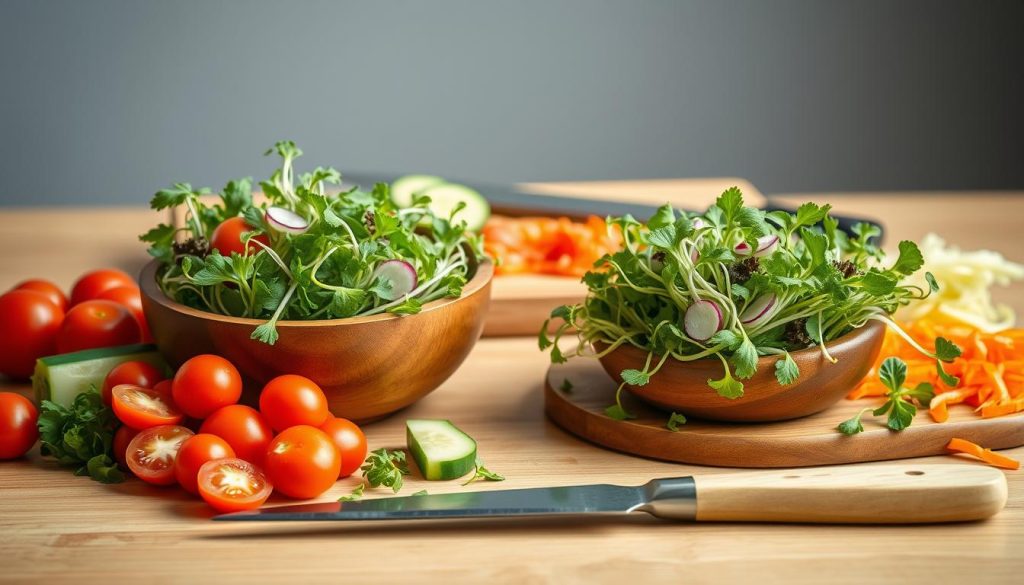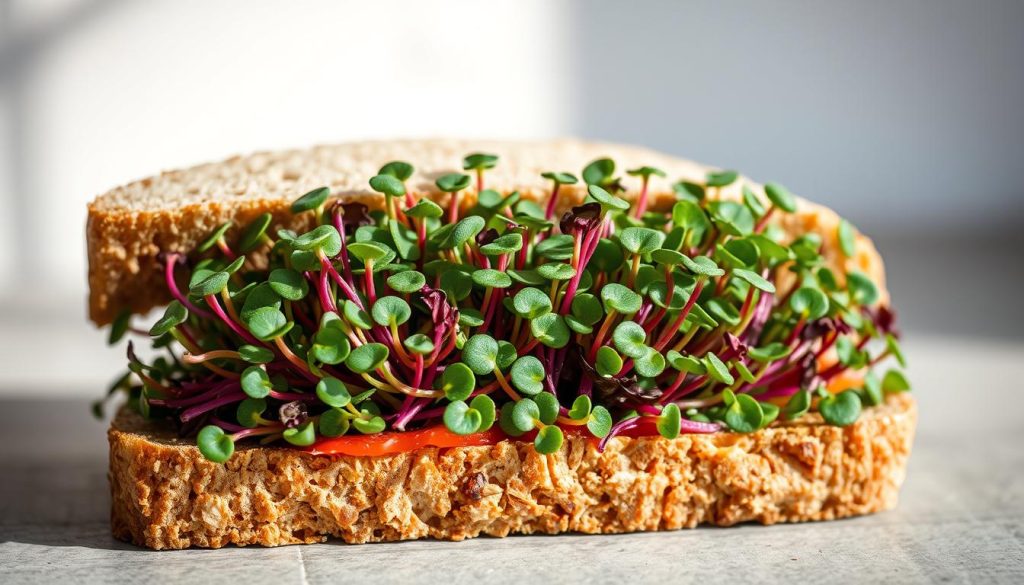Microgreens Culinary Uses
Welcome to the exciting world of microgreens! These tiny greens are changing how we cook in the United States. They pack intense flavors and health benefits, making simple dishes into something special.
Since the 1980s, microgreens have become a big deal in San Francisco. Harvested in just 7-14 days, they add nutrients and beauty to food.
Microgreens are not just for looks; they’re full of nutrients. They have up to 40 times more than regular veggies. Chefs love using them in salads and sandwiches, creating endless recipes.
Key Takeaways
- Microgreens provide concentrated nutrition and vibrant flavors
- Harvest occurs within 1-2 weeks of germination
- Multiple culinary applications across different dishes
- Contains up to 40 times more nutrients than mature vegetables
- Versatile ingredient for professional and home chefs
What Are Microgreens and Why Use Them?
Microgreens have become a big deal in cooking. They change how we use greens in our dishes. These small, nutrient-rich greens do more than just add color to your food. They can make any dish better.
Microgreens are young greens picked 7-21 days after they start growing. They’re usually 1-3 inches tall. Unlike sprouts, these greens have a strong flavor and lots of nutrients that can boost your meals.
Nutritional Powerhouse
Microgreens are super healthy. Research from the University of Maryland shows they have up to 40 times more nutrients than full-grown veggies. They’re full of vitamins and minerals:
- High in vitamin C
- Rich in vitamin E
- Full of antioxidants
- Have more potassium, iron, and zinc
Popular Microgreen Varieties
There are many flavors of microgreens to try:
- Spicy radish microgreens
- Sweet pea shoots
- Robust arugula
- Delicate basil
- Zesty mustard greens
These greens are great in salads, sandwiches, smoothies, and even cocktails. Using microgreens in cooking is a fun and tasty journey.
How to Incorporate Microgreens into Salads
Salads are a great place to use microgreens. They add lots of flavor and nutrition. This makes your salads not only delicious but also beautiful.

Using microgreens in salads can really change your meal. The right mix can make your dish go from good to great.
Fresh Green Salads
Make amazing fresh salads with different microgreens. Here are some great mixes:
- Broccoli microgreens for earthy undertones
- Spicy Rambo radish for a peppery kick
- Purple kohlrabi for vibrant color
- Kale microgreens for nutritional boost
Grain-Based Salad Inspiration
Grain salads get better with microgreens. Mix quinoa or farro with microgreens for a richer taste.
Dressings and Toppings
Make your microgreen salads even better with the right dressings and toppings:
- Light olive oil and vinegar base
- Thinned pesto for herbaceous notes
- Sprinkle of feta cheese
- Toasted sunflower or pumpkin seeds
Try new things with each season. Use spring berries or winter citrus with microgreens. They’re perfect for any time of year.
Elevating Soups and Stews with Microgreens
Microgreens are culinary game-changers that transform ordinary soups and stews into extraordinary dining experiences. These tiny greens pack a powerful punch of flavor and nutrition. They turn simple dishes into gourmet masterpieces with minimal effort.
Delicious microgreens meals aren’t complete without understanding how to integrate these vibrant greens into your favorite comfort foods. Soups and stews provide the perfect canvas for microgreen culinary ideas. These ideas can elevate both taste and visual appeal.
Expert Garnishing Techniques
When adding microgreens to soups, timing and placement are crucial. Consider these professional garnishing strategies:
- Sprinkle microgreens just before serving to maintain their crisp texture
- Use contrasting colors to create visual interest
- Layer microgreens on top of the soup for maximum aesthetic impact
Flavor Combinations to Explore
Different microgreens can dramatically enhance soup flavors. Some exceptional pairings include:
- Radish microgreens with hearty beef stews
- Basil microgreens in tomato-based soups
- Cilantro microgreens for Asian-inspired broths
Best Microgreens for Soups
Not all microgreens are created equal when it comes to soup garnishing. Nutritional powerhouses like kale, spinach, and wheatgrass microgreens offer both flavor and health benefits. Their diverse textures and flavors can transform an ordinary soup into a culinary masterpiece.
With these microgreens culinary ideas, you’ll create soups that are not just meals but memorable dining experiences. Experiment, have fun, and let your creativity shine through these tiny, nutrient-packed greens!
Microgreens in Sandwiches and Wraps
Make your lunchtime meals pop with microgreens. These small but mighty greens add flavor and nutrition to your sandwiches and wraps.

Creating a great sandwich with microgreens is all about layering and mixing. Both chefs and home cooks are finding new ways to use these tiny greens.
Layering with Proteins
Pairing microgreens with proteins is key. Here are some tasty combinations:
- Grilled chicken with spicy radish microgreens
- Smoked salmon with delicate arugula microgreens
- Turkey and sunflower microgreen blend
Spreading Flavor
Microgreens pack a punch of flavor, making them a great substitute for condiments. Spread them on bread or wraps for a flavor boost. They’re packed with nutrients, offering up to 40 times more than mature veggies.
Unique Combinations
Try these unique sandwich ideas with microgreens:
- Creamy avocado with peppery mustard microgreens
- Smoky bacon paired with sweet pea shoot microgreens
- Mediterranean-style wrap with basil microgreens and hummus
With 50% of people choosing sandwiches with microgreens, they’re more than a trend. They’re a nutritional game-changer for lunch.
Creative Uses in Breakfast Dishes
Microgreens can make your morning meals amazing. They add vibrant flavors and health benefits. Growing in just 7 to 14 days, they’re a fresh and sustainable choice for breakfast.
Smoothies and Juices: Nutrient-Packed Morning Boost
Adding microgreens to smoothies is easy. They are packed with vitamins and minerals, up to 40 times more than regular veggies.
- Blend micro basil into fruit smoothies for an herbal twist
- Add pea shoots to green juices for extra protein
- Mix red cabbage microgreens for a vitamin C boost
Omelets and Scrambles: Colorful Breakfast Upgrades
Make your egg dishes special with microgreens. They add a burst of flavor and color.
- Sprinkle micro jade greens on top of scrambled eggs
- Fold curly microgreens into fluffy omelets
- Create a breakfast skillet with mixed microgreen varieties
Avocado Toast Enhancements
Avocado toast gets a boost from microgreens. You can make it like a restaurant dish in 15 minutes.
- Layer different microgreen varieties for complex flavors
- Add a sprinkle of sea salt to complement microgreen freshness
- Experiment with seasonal microgreen combinations
Keep your microgreens fresh by storing them in damp paper towels in the fridge. They last up to a week. Wash them just before using to keep them crisp and nutritious.
Enhancing Main Courses with Microgreens
Microgreens are a game-changer in cooking. They turn simple dishes into amazing meals. These small, nutrient-rich greens add flavor and beauty to many dishes.
Chefs in the U.S. love using microgreens to make main courses pop. They are packed with nutrients and have strong flavors. This makes them a great choice for creative dishes.
Grilled Meats with Microgreen Flair
Make grilled meats even better with microgreens. Try these pairings:
- Radish microgreens with grilled steak for a peppery kick
- Cilantro microgreens alongside grilled chicken for fresh complexity
- Mustard microgreens to complement barbecued pork
Vegetarian Microgreen Masterpieces
Vegetarian dishes get a boost from microgreens. Layer different microgreens for flavor and nutrition.
- Sunflower microgreens in grain bowls
- Pea shoot toppings on roasted vegetable platters
- Broccoli microgreens mixed into vegetable stir-fries
Stir-Fries and Sautéed Delights
Microgreens add crunch and flavor to quick dishes. Daikon Radish and Mizuna are great in stir-fries.
Chefs say to add microgreens at the end of cooking. This keeps their texture and flavor fresh. It makes your dishes stand out.
Microgreens for Garnishing and Presentation
Turning simple dishes into works of art is more than just about taste. Delicious Microgreens Meals can make your meals look and taste amazing. They add a visual touch that’s both beautiful and flavorful.
Professional chefs know that looks matter a lot. They say 75% of what we enjoy about food is how it looks. Microgreens are perfect for adding color and texture to your dishes.
Plating Techniques for Maximum Impact
- Use microgreens as delicate top garnishes
- Create color contrasts on white plates
- Sprinkle strategically around protein centerpieces
- Layer microgreens for dimensional depth
Color and Texture Considerations
When planning your Microgreens Culinary Ideas, think about the colors and textures they bring. Each type of microgreen has its own look:
- Red amaranth for deep crimson accents
- Spicy radish microgreens for bright green highlights
- Pea shoots for soft, elegant touches
Eye-Catching Combinations
Choosing the right microgreens is key. Mix and match colors and textures to make your plates pop. This will impress anyone, whether you’re a home cook or a pro chef.
Studies show 68% of people are willing to pay more for food that looks good. Learning how to use microgreens can turn simple meals into unforgettable experiences.
Microgreens in Beverages and Cocktails
Microgreens are changing the way we enjoy drinks. They add vibrant flavors and nutrients to both alcoholic and non-alcoholic drinks. This makes for exciting new tastes for those who love to try different drinks.
Infusions and Syrups
Microgreens infusions bring new flavors to drinks. Bartenders and home mixologists can mix unique tastes by soaking microgreens in simple syrups. This adds a rich taste to cocktails and mocktails.
- Wheatgrass and broccoli microgreens work wonderfully in smoothies
- Gin cocktails benefit from herb-based microgreen garnishes
- Lemon balm microgreens provide exceptional flavor profiles
Garnish Ideas
Microgreens are perfect for garnishes. They make drinks look great and add a hint of flavor. Chefs and mixologists use them to make drinks look amazing on Instagram.
Flavor Balancing
Choosing the right microgreens is key. Spicy radish microgreens can spice up a bloody mary. Delicate pea shoots can add a light touch to a gin drink. It’s all about matching the microgreen’s flavor to the drink’s.
- Match microgreen intensity to beverage strength
- Consider complementary flavor combinations
- Experiment with different microgreen varieties
Tips for Growing Microgreens at Home
Growing microgreens in your kitchen can make your cooking fresh and full of nutrients. These small greens are easy to grow, even for beginners. With a few tools and some basic knowledge, you can grow your own vibrant greens at home.
Choosing high-quality seeds is the first step to growing microgreens. Pick organic, untreated seeds made for sprouting. Broccoli, radish, and sunflower seeds are great for cooking with microgreens. Use a container about 16 x 6 inches, needing only 1-2 inches of growing medium like peat or coconut coir.
The right growing environment is key for microgreens. Place your tray near a window or use grow lights. Keep the soil moist by watering from the bottom to avoid mold. Most microgreens are ready to harvest in 7-14 days, offering a quick source of fresh, nutritious greens.
When it’s time to harvest, use clean scissors and cut just above the soil. Store your microgreens in an airtight container with a dry paper towel. They’ll stay fresh for 3-5 days in the fridge. By following these simple steps, you’ll always have fresh microgreens to enhance your cooking.